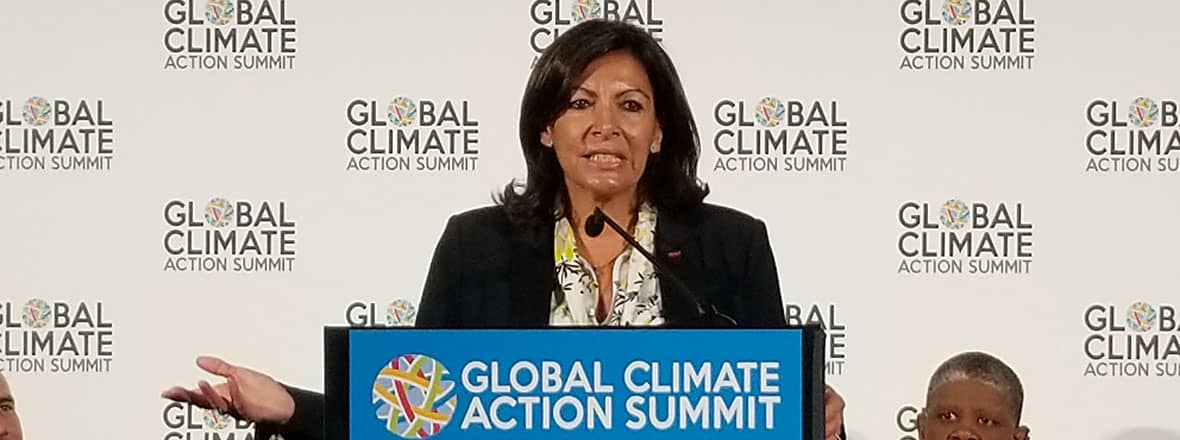
One of Donald Trump’s first acts after taking office as president of the United States was to withdraw the U.S. from the historic Paris Agreement, the global action plan to address climate change.
While the effects of this withdrawal could be devastating, progress on climate change policy is being powered by local and regional governments around the world, as well as private-sector initiatives — often with women front and center.
The woman in the lead is Anne Hidalgo, the iconic mayor of Paris. “I am a mother of three, and am directly and personally affected,” she stated, in discussing the legal case she and the mayors of Brussels and Madrid have brought against the European Commission for its weakening of EC diesel regulations under pressure from automotive lobbies. Lawsuits against the EC require the plaintiff to be “directly and personally affected” by the regulations under complaint. In September, in a rousing start to the Global Climate Action Summit (GCAS 2018), a pivotal gathering of state, local, business, and civil society leaders on climate, Hidalgo listed the arguments of her legal brief. “I am directly and personally affected when hospitals report to me an increased number of children suffering from asthma; when doctors report cancers rising from air pollution.… We mayors, governors, are all directly and personally affected and [must] defend and enable [our citizens] to breathe.”
Hidalgo chairs C40, a powerful global network of cities committed to “delivering on the most ambitious goals of the Paris Agreement” regardless of national or regional policies. Set up by former New York City Mayor Michael Bloomberg in 2005 with 40 mayors, it now has a membership of 96 cities and growing. As the mayor of Paris, Hidalgo, along with her colleagues, is working to keep the progress toward slowing global warming on track despite the Trump administration’s withdrawal. A highlight of GCAS was the announcement by California Governor Jerry Brown that he had signed State Senate Bill 100, which sets the goal for California to be carbon neutral by 2045, with 40 percent emissions reductions by 2030.
After Trump’s withdrawal, Brown had taken immediate steps to head to Beijing, where he met with President Xi and signed an agreement with the Chinese government to protect the Paris Agreement goals. This was the first international agreement between a national government and a state government based on a negotiated U.N. agreement. Former Mayor Bloomberg created a coalition pulling together American cities and state governments called #AmericasPledge. Under the Paris Agreement, governments must submit a national compliance report to the United Nations Framework Convention on Climate Change. Since the Trump administration was not going to create a report, #AmericasPledge submitted an alternative national report on U.S. compliance. This was the first time that the United Nations had received a compliance report not from a national government but from the people of a nation.
#AmericasPledge hinges not only on Bloomberg’s financial support but on the enormous economic power and political muscle of the California state government. At the GCAS, California’s political leaders presented results achieved by their state: Even with tighter emissions enforcement, California’s economy grew from sixth largest to fifth largest in the world over the last few years.
Leading this work is Mary Nichols, head of the California Air Resources Board (CARB), California’s clean air agency. Nichols is deceptively unassuming, but at every panel and press conference it was she who answered all the questions and gave the clearest explanations of how California is taking on the linked challenges of air pollution and climate change.
“Long before we focused on climate change, we were tackling air pollution,” explained Nichols. “Jerry Brown was governor for the first time 1974 when I came into CARB. We took a forefront approach, setting targets based on science, working to quantify and monitor air pollution. We enacted fiscal incentives for solutions, and gave regulatory bodies resources and authority to do the job.” From the late 1970s to 2008, California’s population doubled, and the number of vehicles on the road tripled, yet air pollution dropped dramatically. As a result, said Nichols, $65 billion in health costs was saved. “Everything we do for climate is linked to our goals for clean air.”
Women leaders within California’s legislature have been key in giving CARB the resources and legal power to implement its strong emissions regulations. Fran Pavley was a middle school teacher for 27 years. She decided to run for office after seeing the impact of pollution on her students’ lives and health. “My students in Los Angeles had asthma,” she said. In her 14 years in the California legislature, Pavley was the author of the Global Warming Solutions Act of 2006, which created a groundbreaking cap-and-trade system to reduce California's greenhouse gas emissions. In 2016, she cemented her legacy by authoring and passing a law to extend California's emissions reduction goals to 40 percent below 1990 levels by 2030.
In the absence of federal leadership, the growing green economies in U.S. states and around the world are also being powered by energy companies and energy investors whose decision-makers are increasingly women. Meade Harris, an American former energy company executive, set up the Hawthorn Club in 2011 to promote the advancement of women and facilitate gender diversity within the energy sector.
The club now has over 80 energy company members. Its former chair, Nancy Pfund, is founder and managing partner of DBL Partners, a venture capital firm investing in environmental and financial returns. California’s announcement of its 100 percent renewal energy plans is “a great shot in the arm” for climate resilience, said Pfund. Governor Brown “has thrown the gauntlet as [the] leader of the country. Investors are already rebalancing portfolios away from fossil fuels and carbon.”
But this wave of success led by California, Paris, and New York will have to make headway in developing countries like India, where carbon emissions are still increasing due to a rapidly growing economy still largely powered by coal and fossil fuels. Renewable energy is still only 12 percent of India’s energy mix, but it is set to ramp up substantially with Energy Minister Piyush Goyal’s recent announcement that India plans to add 175 gigawatts from renewable sources by 2022.
Speaking at the summit were the mayors of Pune and Ahmedabad, both women. Mukta Tilak, mayor of Pune, a mid-size city of 5 million residents, stated her goals as providing “clean air, clean energy, clean living.” In 2017, as part of an effort to absorb carbon, Pune planted 40,000 trees, and this year the city plans to plant 100,000 trees. Bike-sharing programs have been started on campuses, and 2,000 electric buses are planned as replacements to the city’s diesel fleet. Pune is also deploying bio-digesters for five tons of household and community waste to turn it into electricity for the area. The program has a gender empowerment component: The primary waste collectors are women. Organic waste collected is converted to electricity; workers can keep recyclable waste and redeem it for cash.
Participation in the green economy by female workers is also a key factor driving positive results on climate. At a Natural Resources Defense Council press briefing, Heena Dave, now a manager at Self Employed Women’s Association (SEWA), a union of self-employed women workers in India, explained that she started out as a salt-pan worker among 15,000 women retrieving salt from brine in the marshes of the Rann of Kutch. Today, under a SEWA Bank program, these workers are able to borrow bank funds for solar pumps. The loans have been used by 1,100 women to replace their diesel pumps with solar pumps, saving the expense of 800 liters of diesel per season per family. Accompanying her to GCAS was Gauri Behn, a salt worker who proudly told the conference that she now has two solar pumps and can pay for her children’s education with the extra net income.
This piece was original published by Women's Media Centre
 The State of India’s Pollution Control Boards - Are they in the green?
The State of India’s Pollution Control Boards - Are they in the green?
Centre for Policy Research, April 2023
 Tracing the Hazy Air 2023 - Progress Report on National Clean Air Programme (NCAP)
Tracing the Hazy Air 2023 - Progress Report on National Clean Air Programme (NCAP)
Centre for Research on Energy and Clean Air (CREA), 2023




